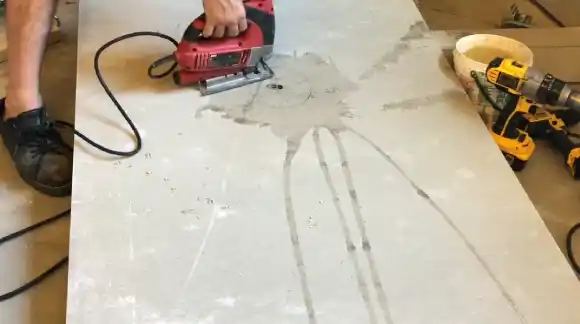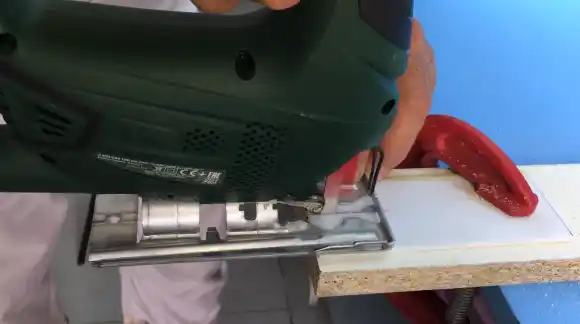When you have to work with cement fiber boards and need to make precise cuts, you might wonder whether a jigsaw is up to the task.
While jigsaws are primarily designed for wood, with the right precautions and steps, you can indeed cut cement boards using a jigsaw.
To cut cement fiber board with a jigsaw, you have to use a carbide-tipped blade designed specifically for cutting cement fiber board. You should also consider several other aspects when cutting cement boards with a jigsaw.
So, we will discuss all the steps of cutting cement boards with a jigsaw to ensure clean, accurate cuts.
How to Cut Cement Board With a Jigsaw: Steps to Follow

To cut cement board with a jigsaw, follow these steps:
- Step 1: Gather the necessary materials and supplies
- Step 2: Measure and mark the cutting area
- Step 3: Setup your jigsaw
- Step 4: Lubricate the blade
- Step 5: Set jigsaw speed
- Step 6: Put on safety gear
- Step 7: Secure the cement board
- Step 8: Start cutting
Let us discuss each step in detail so you can cut your cement board effectively with a jigsaw.
Step 1: Gather the Necessary Materials and Supplies
Gather all the necessary materials and supplies to start cutting cement boards with a jigsaw. Make sure you have:
- A jigsaw with a carbide-tipped blade designed for cutting cement fiberboard
- A sturdy workbench or surface to work on
Don’t forget to grab:
- Your measuring tape
- Pencil or marker for marking measurements
- Safety goggles
- Dust mask to protect yourself
Also, have some lubricant like water or mineral spirits on hand.
Step 2: Measure and Mark the Cutting Area
After collecting your materials and supplies, measure and mark the cutting area. To get the dimensions for your project, place the cement board on a flat and stable surface and use measuring tape to determine the dimensions required.
Once you have determined the measurements needed, use a pencil or marker to mark the cutting lines directly onto the surface of the cement board.
Ensure the lines are straight and clearly visible for accurate cutting. Double-check your measurements to avoid errors leading to wasted material or inaccurate cuts.
When marking your cutting lines, consider adding a margin if you need to fit the cut piece snugly into a particular space, allowing for a small buffer.
Use a straightedge or T-square to ensure your cutting lines are perfectly straight and at the desired angles. Consider any corners or curves that need to be cut and mark them accordingly.
Step 3: Setup Your Jigsaw
Before proceeding with the cutting process, ensure your jigsaw is set up correctly. Choose a jigsaw blade with a carbide tip specifically for cutting cement fiber.
Unplug your jigsaw or disconnect the battery before starting the setup process. Examine the jigsaw to locate the blade attachment mechanism, usually a quick-release lever or a screw-type fastening system.
Insert the new carbide-tipped jigsaw blade into the blade attachment mechanism. It ensures that the teeth of the blade are facing forward and in the direction of the jigsaw’s cutting motion.
Tighten the blade attachment mechanism securely to lock the blade in place. Ensure the blade is firmly seated in the jigsaw to prevent any wobbling during cutting, which could lead to imprecise cuts or potential accidents.
Step 4: Lubricate the Blade
To prevent the jigsaw blade from overheating and prolong its life, apply a lubricant such as water, mineral spirits, or WD-40 to the cutting area. This will also help in reducing dust production.
Fill a spray bottle with the chosen lubricant or have a small container of it nearby to apply manually.
Adjust the nozzle to provide a fine and even lubricant mist if using a spray bottle. If using a manual application, dip a small brush or cloth into the lubricant to apply it to the blade.
Before powering on the jigsaw, apply a light coat of lubricant to the entire length of the jigsaw blade. Reapply the lubricant periodically during the cutting process to keep the blade cool and prevent overheating.
Step 5: Set Jigsaw Speed

Set your jigsaw to a low-speed setting. A slower speed minimizes dust generation and helps to maintain better control over the cut.
If your jigsaw is corded, plug it into a power outlet. If it’s a cordless model, ensure the battery is fully charged and properly inserted into the jigsaw.
Check the power switch or trigger on the jigsaw to ensure it is in the “OFF” position before connecting it to a power source.
Once the jigsaw is plugged in or the battery is connected, locate the variable speed control dial or trigger on the jigsaw. Some models have a dial that allows you to set the speed manually, while others have a variable speed trigger that adjusts the speed based on how much pressure you apply to the trigger.
If your jigsaw has a speed control dial, initially turn it to the lowest speed setting before starting the jigsaw.
When your jigsaw has a variable speed trigger, press lightly on the trigger to activate the lowest speed.
Step 6: Put on Safety Gear
Before cutting the cement board, wear safety gear such as safety goggles and a dust mask. These will protect your eyes from debris and prevent inhalation of fine cement dust when you cut cement boards with a jigsaw.
Step 7: Secure the Cement Board
Now that you have put on your safety gear, it’s time to securely fasten the cement board before cutting it with a jigsaw.
Use clamps or heavy objects to hold the board in place, ensuring it doesn’t slide or move during cutting. Make sure the clamps are tightened properly but not too tight.
Step 8: Start Cutting
Once your cement board is securely placed, align the jigsaw blade with the marked line and begin cutting slowly and steadily. Allow the blade to do the work and avoid forcing it through the cement board, as it could cause damage to the blade or the board itself.
To cut holes in cement boards, such as for sinks or other plumbing projects, start by drilling a pilot hole in a scrap piece of board. Do not drill directly on the cut line. This helps prevent any damage to the smoothness of the sinkhole and creates an opening that can accommodate the jigsaw blade.
Ensure that the board is fully supported while drilling to prevent cracks in the board.
How thick of a cement board can a jigsaw cut?
A jigsaw with a metal blade can easily slice through cement backer boards up to 1/4 inch thick, making it a versatile tool for various DIY projects.
But remember that this thickness is within the capability of most jigsaw blades designed for general-purpose cutting.
How often should you replace the jigsaw blade when cutting cement boards?

Based on several factors, including the type of cement board, material thickness, cutting speed, and blade quality, the frequency of replacing jigsaw blades when cutting cement board can vary.
But, inspecting the blade after every 6 to 8 cuts is generally recommended. If you see signs of wear like decreased cutting efficiency, increased heat generation, and chipping around the edges, it’s time to replace it.
Effortlessly Cut Cement Board with a Jigsaw
As you can see, cutting a cement board using a jigsaw is definitely possible. Using this versatile tool, you can easily cut through different thicknesses of cement board.
Just make sure to use the right blade and take proper safety precautions. And remember, when cutting cement boards, replace the jigsaw blade frequently to ensure clean and precise cuts.
With these tips in mind, you’ll be able to tackle your cement board projects with ease.



